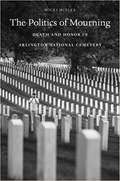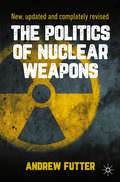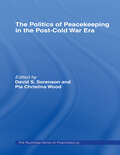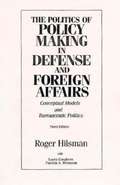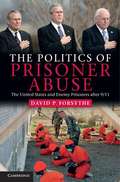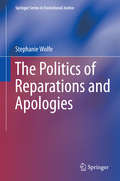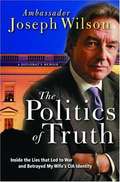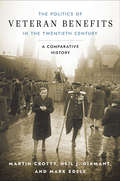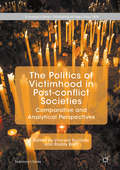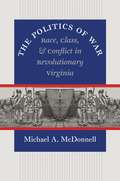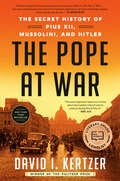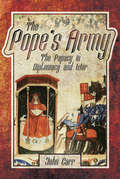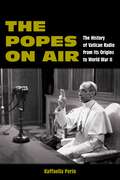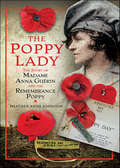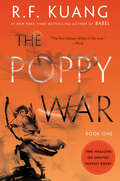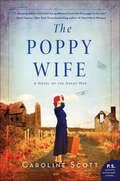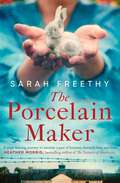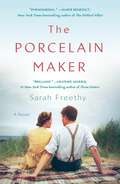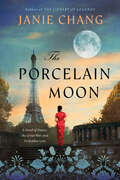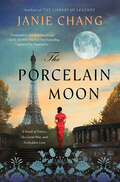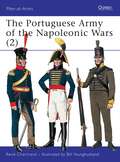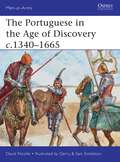- Table View
- List View
The Politics of Mourning
by Micki McelyaArlington National Cemetery is America's most sacred shrine, a destination for four million visitors who each year tour its grounds and honor those buried there. For many, Arlington's symbolic importance places it beyond politics. Yet as Micki McElya shows, no site in the United States plays a more political role in shaping national identity.
The Politics of Nuclear Weapons: New, updated and completely revised
by Andrew FutterThis comprehensively updated second edition provides an introduction to the political, normative, technological and strategic aspects of nuclear weaponry. It offers an accessible overview of the concept of nuclear weapons, outlines how thinking about these weapons has developed and considers how nuclear threats can continue to be managed in the future. This book will help you to understand what nuclear weapons are, the science behind their creation and operation, why states build them in the first place, and whether it will be possible for the world to banish these weapons entirely. Essential reading for all students of International Relations, Security Studies and Military History.
The Politics of Peacekeeping in the Post-Cold War Era (Cass Series On Peacekeeping Ser. #Vol. 17)
by David S. Sorenson Pia Christina WoodMost literature on peacekeeping narrowly focuses on particular peacekeeping operations, and the political bargaining between peacekeeping participants. However, there is very little published research on why nations actually commit forces to peacekeeping operations. This new book meets this need.The authors focus specifically on
The Politics of Policy Making in Defense and Foreign Affairs: Conceptual Models and Bureaucratic Politics (Third Edition)
by Roger HilsmanAuthor Roger Hilsman brings to this Third Edition the insight and experience from a lifetime in military and foreign affairs. In the Third Edition of this classic volume, he sets forth a realistic description of how Washington actually works in the making of defense policy and foreign affairs. He achieves this by exploring the various conceptual models and power centers (both individuals and instructions) driving traditional and contemporary defense and foreign policy.
The Politics of Prisoner Abuse: The United States and Enemy Prisoners After 9/11
by David P. ForsytheWhen states are threatened by war and terrorism, can we really expect them to abide by human rights and humanitarian law? David P. Forsythe's bold analysis of US policies towards terror suspects after 9/11 addresses this issue directly. Covering moral, political, and legal aspects, he examines the abuse of enemy detainees at the hands of the United States. At the center of the debate is the Bush Administration, which Forsythe argues displayed disdain for international law, in contrast to the general public's support for humanitarian affairs. Forsythe explores the similarities and differences between Presidents Obama and Bush on the question of prisoner treatment in an age of terrorism and asks how the Administration should proceed. The book traces the Pentagon's and CIA's records in mistreating prisoners, providing an account which will be of interest to all those who value human rights and humanitarian law.
The Politics of Reparations and Apologies
by Stephanie Wolfe The Politics of Reparations and Apologies examines the evolution and dynamics of reparation politics and justice. The volume introduces the key concepts, theories, and terms associated with social movements and in particular, the redress and reparation movement (RRM). Drawing from RRMs that have their foundation in World War II--the German genocides, the United States internments, and the Japanese "comfort women" system-- the volume explores each case study's relative success or failure in achieving its goals and argues that there are overarching trends that can explain success and failure more generally in the RRM movement. Using the backdrop of international criminal law and normative concepts of reparations, the volume establishes and analyzes the roles of reparations and apologies in obtaining transitional justice. In each case study, there is a detailed rundown of the political actions that were attempted to obtain redress and reparation for the victims, of how successful the attempts were, and of the crucial factors which influenced the relative success or failure. Crucially, the volume offers a comparative framework of the actions that contribute to a successful outcome for transitional justice. With the increasing normative expectation of justice in post-conflict situations, this volume is a valuable resource for researchers in international affairs, human rights, political science, and conflict studies.
The Politics of Torture
by Tracy LightcapWhy did it happen? Why did the United States begin to torture detainees during the War on Terror? Instead of an indictment, this book presents an explanation. Crises produce rare opportunities for overcoming the domestic and foreign policylogjams facing political leaders. But what if the projects used to address the crisis and provide cover for their domestic policy initiatives come under serious threat from clandestine opponents? Then the restraints on interrogation can be overwhelmed, leading to the creation ofinformal institutions that allow the official establishment of torture. These ideas are tested using comparative historical narratives drawn from two cases where torture was adopted - the War on Terror and the Stalinist Terror - and one where it was not - the Mexican War. The book concludes with some thoughts about how the United States can avoid the legal establishment of torture in the future.
The Politics of Truth: A Diplomat's Memoir
by Joseph WilsonAmbassador Wilson writes a very engaging memoir of how he wound up in the diplomatic service. We follow his career from support staff overseas, to ambassador of several small African nations. He was also the last charge d'affairs in Iraq after the war began in 1990. He tells the story of how he got tangled up in the hardball and brutal politics of the current Bush administration, and how it differs from the norms of civil discourse in politics, and even from the first Bush administration, which praised Wilson lavishly.
The Politics of Truth: Inside the Lies That Put the White House on Trial and Betrayed My Wife's CIA Identity
by Joseph WilsonOne of last year's most controversial books and a "New York Times" bestseller, with an investigative epilogue by a prominent Washington journalist and a new introduction by the author on the anatomy of the Bush administration's smear campaign against him.
The Politics of Veteran Benefits in the Twentieth Century: A Comparative History
by Mark Edele Martin Crotty Neil J. DiamantWhat happened to veterans of the nations involved in the world wars? How did they fare when they returned home and needed benefits? How were they recognized—or not—by their governments and fellow citizens? Where and under what circumstances did they obtain an elevated postwar status?In this sophisticated comparative history of government policies regarding veterans, Martin Crotty, Neil J. Diamant, and Mark Edele examine veterans' struggles for entitlements and benefits in the United States, the United Kingdom, Japan, Taiwan, the Soviet Union, China, Germany, and Australia after both global conflicts. They illuminate how veterans' success or failure in winning benefits were affected by a range of factors that shaped their ability to exert political influence. Some veterans' groups fought politicians for improvements to their postwar lives; this lobbying, the authors show, could set the foundation for beneficial veteran treatment regimes or weaken the political forces proposing unfavorable policies. The authors highlight cases of veterans who secured (and in some cases failed to secure) benefits and status after wars both won and lost; within both democratic and authoritarian polities; under liberal, conservative, and even Leninist governments; after wars fought by volunteers or conscripts, at home or abroad, and for legitimate or subsequently discredited causes. Veterans who succeeded did so, for the most part, by forcing their agendas through lobbying, protesting, and mobilizing public support. The Politics of Veteran Benefits in the Twentieth Century provides a large-scale map for a research field with a future: comparative veteran studies.
The Politics of Victimhood in Post-conflict Societies: Comparative And Analytical Perspectives (St Antony's)
by Roddy Brett Vincent DruliolleThis volume sheds new light upon the role of victims in the aftermath of violence. Victims are central actors in transitional justice, the politics of memory and conflict resolution, yet the analysis of their mobilisation and political influence in these processes has been neglected. After introducing and explaining the reasons for this limited interest, the book’s chapters focus on a range of settings and draw on different disciplines to offer insights into the interrelated themes of victimhood – victims, their individual and collective identities, and their role in and impact upon post-conflict societies – and the politics of victimhood – meaning how victimhood is defined, negotiated and contested, both socially and politically. Because it outlines a stimulating research agenda and challenges the view that victims are passive or apolitical, this interdisciplinary volume is a significant contribution to the literature and will be of interest to scholars from disciplines such as law, anthropology, political science, human rights, international studies, and to practitioners.
The Politics of War
by Michael A. McdonnellWar often unites a society behind a common cause, but the notion of diverse populations all rallying together to fight on the same side disguises the complex social forces that come into play in the midst of perceived unity. Michael A. McDonnell uses the Revolution in Virginia to examine the political and social struggles of a revolutionary society at war with itself as much as with Great Britain.McDonnell documents the numerous contests within Virginia over mobilizing for war--struggles between ordinary Virginians and patriot leaders, between the lower and middle classes, and between blacks and whites. From these conflicts emerged a republican polity rife with racial and class tensions. Looking at the Revolution in Virginia from the bottom up, The Politics of War demonstrates how contests over waging war in turn shaped society and the emerging new political settlement. With its insights into the mobilization of popular support, the exposure of social rifts, and the inversion of power relations, McDonnell's analysis is relevant to any society at war.
The Politics of War Memory in Japan: Progressive Civil Society Groups and Contestation of Memory of the Asia-Pacific War (The University of Sheffield/Routledge Japanese Studies Series)
by Kamila SzczepanskaSince the 1990s, questions of Japanese wartime conduct, apologies for aggression, and compensation to former victims of the country’s imperial policies, have been brought to the fore of national and regional politics. The state is undoubtedly the most important actor in the process of memory production and along with conservative legislators and the grass-root revisionist movement there has been a consistent trend towards denying or undermining the existing acknowledgments of responsibility for Japan’s wartime past. However, to fully comprehend war memory in Japan, due attention must be paid to competing discourses that demand an alternative view, and only then can the complexity of Japanese war memory and attitudes towards the legacies of the Asia-Pacific war be understood. The Politics of War Memory in Japan examines the involvement of five civil society actors in the struggle over remembering and addressing the wartime past in Japan today. In studying progressive war memory activists, it quickly becomes clear that the apologia by conservative politicians cannot be treated as representative of the opinion of the majority of the Japanese public. Indeed, this book seeks to remedy the disparity between studies devoted to the official level of addressing the ‘history issue’ and the grass-root historical revisionist movement on the one side, and progressive activism on the other. Furthermore, it contributes to scholarly debates on the state of civil society in Japan, challenging the characterisation of Japanese civil society as a depoliticised space by demonstrating a more contentious side of civil society activism. Drawing important new empirical research, this book will be of huge interest to students and scholars of Japanese civil society, Japanese politics, Japanese history and memory in Japan.
The Pope at War: The Secret History of Pius XII, Mussolini, and Hitler
by David I. KertzerNEW YORK TIMES BESTSELLER • &“The most important book ever written about the Catholic Church and its conduct during World War II.&”—Daniel Silva&“Kertzer brings all of his usual detective and narrative skills to [The Pope at War] . . . the most comprehensive account of the Vatican&’s relations to the Nazi and fascist regimes before and during the war.&”—The Washington Post Based on newly opened Vatican archives, a groundbreaking, explosive, and riveting book about Pope Pius XII and his actions during World War II, including how he responded to the Holocaust, by the Pulitzer Prize–winning author of The Pope and MussoliniWINNER OF THE JULIA WARD HOWE AWARD • LONGLISTED FOR THE PEN/JACQUELINE BOGRAD WELD AWARD • ONE OF THE BEST BOOKS OF THE YEAR: The New YorkerWhen Pope Pius XII died in 1958, his papers were sealed in the Vatican Secret Archives, leaving unanswered questions about what he knew and did during World War II. Those questions have only grown and festered, making Pius XII one of the most controversial popes in Church history, especially now as the Vatican prepares to canonize him.In 2020, Pius XII&’s archives were finally opened, and David I. Kertzer—widely recognized as one of the world&’s leading Vatican scholars—has been mining this new material ever since, revealing how the pope came to set aside moral leadership in order to preserve his church&’s power.Based on thousands of never-before-seen documents not only from the Vatican, but from archives in Italy, Germany, France, Britain, and the United States, The Pope at War paints a new, dramatic portrait of what the pope did and did not do as war enveloped the continent and as the Nazis began their systematic mass murder of Europe&’s Jews. The book clears away the myths and sheer falsehoods surrounding the pope&’s actions from 1939 to 1945, showing why the pope repeatedly bent to the wills of Hitler and Mussolini.Just as Kertzer&’s Pulitzer Prize–winning The Pope and Mussolini became the definitive book on Pope Pius XI and the Fascist regime, The Pope at War is destined to become the most influential account of his successor, Pius XII, and his relations with Mussolini and Hitler. Kertzer shows why no full understanding of the course of World War II is complete without knowledge of the dramatic, behind-the-scenes role played by the pope. &“This remarkably researched book is replete with revelations that deserve the adjective &‘explosive,&’&” says Kevin Madigan, Winn Professor of Ecclesiastical History at Harvard University. &“The Pope at War is a masterpiece.&”
The Pope's Army: The Papacy in Diplomacy and War
by John CarrFor much of its 2,000-year history, the Roman Catholic Church was a formidable political and military power, in contrast to its pacifist origins and its present concentration on spiritual matters. The period of political and military activism can be dated to roughly between 410, when Pope Innocent I vainly tried to avert the sack of Rome by the Visigoths, and about 1870, when Pope Pius IX was abandoned by his protectors, the French Army, and forced to submit to the new Italian state by surrendering any political power the Vatican had left. During those centuries, the popes employed every means at their disposal, including direct military action, to maintain their domains centered on Rome. Some pontiffs, such as Alexander VI, Julius II (15th century), plus the energetic Borgia popes later, built the Papal States into a power in their own right. In the following century and a half, Europe&’s destructive religious wars almost always had a papal component, with the Lateran and later Vatican fielding their own armies. Climaxing the story are the little-known yet bitter late-nineteenth century battles between the papal volunteers from all over Europe and America, and the Italian nationalists who ultimately prevailed. John Carr narrates the story of Papal military clout with engaging verve.
The Popes on Air: The History of Vatican Radio from Its Origins to World War II (World War II: The Global, Human, and Ethical Dimension)
by Raffaella PerinThe story of the origin of Vatican Radio provides a unique look at the history of World War IIThe book offers the first wide-ranging study on the history of Vatican Radio from its origins (1931) to the end of Pius XII’s pontificate (1958) based on unpublished sources. The opening of the Secret Vatican Archives on the records regarding Pius XII will shed light on the most controversial pontificate of the 20th century. Moreover, the recent rearrangement of the Vatican media provided the creation of a multimedia archive that is still in Fieri.This research is an original point of view on the most relevant questions concerning these decades: the relation of the Catholic Church with the Fascist regimes and Western democracies; the attitude toward anti-Semitism and the Shoah in Europe, and in general toward the total war; the relationship of the Holy See with the new media in the mass society; the questions arisen in the after-war period such as the Christian Democratic Party in Italy; the new role of women; and anti-communism and the competition for the consensus in the social and moral order in a secularized society.
The Poppy Lady: The Story of Madame Anna Guérin and the Remembrance Poppy
by Heather JohnsonMadame Anna Guérin is the fascinating personality behind the title ‘The Poppy Lady’. Her idea of the ‘Inter-Allied Poppy Day’ gave work to women and children in the devastated areas of France, in addition to offering support for First World War veterans. Born in 1878, she was an early feminist, becoming financially independent. During the First World War, and the immediate years after the Armistice, many people knew of Madame Guérin’s reputation as a selfless fundraiser for French and American charities. Her speeches inspired many people to make generous donations. Having had her name lost in the mists of time, this is the first biography of Madame E. Guérin. The book follows her extraordinary story as ‘The Poppy Lady’, a woman born before her time, but confined to anonymity for too long.
The Poppy War: A Novel (The Poppy War #1)
by R. F KuangOne of Time Magazine’s 100 Best Fantasy Books of All Time“I have no doubt this will end up being the best fantasy debut of the year...I have absolutely no doubt that [Kuang’s] name will be up there with the likes of Robin Hobb and N.K. Jemisin.” -- BooknestFrom #1 New York Times bestselling author of Babel and Yellowface, the brilliantly imaginative debut of R.F. Kuang: an epic historical military fantasy, inspired by the bloody history of China’s twentieth century and filled with treachery and magic, in the tradition of Ken Liu’s Grace of Kings and N.K. Jemisin’s Inheritance Trilogy.When Rin aced the Keju—the Empire-wide test to find the most talented youth to learn at the Academies—it was a shock to everyone: to the test officials, who couldn’t believe a war orphan from Rooster Province could pass without cheating; to Rin’s guardians, who believed they’d finally be able to marry her off and further their criminal enterprise; and to Rin herself, who realized she was finally free of the servitude and despair that had made up her daily existence. That she got into Sinegard—the most elite military school in Nikan—was even more surprising.But surprises aren’t always good.Because being a dark-skinned peasant girl from the south is not an easy thing at Sinegard. Targeted from the outset by rival classmates for her color, poverty, and gender, Rin discovers she possesses a lethal, unearthly power—an aptitude for the nearly-mythical art of shamanism. Exploring the depths of her gift with the help of a seemingly insane teacher and psychoactive substances, Rin learns that gods long thought dead are very much alive—and that mastering control over those powers could mean more than just surviving school.For while the Nikara Empire is at peace, the Federation of Mugen still lurks across a narrow sea. The militarily advanced Federation occupied Nikan for decades after the First Poppy War, and only barely lost the continent in the Second. And while most of the people are complacent to go about their lives, a few are aware that a Third Poppy War is just a spark away . . .Rin’s shamanic powers may be the only way to save her people. But as she finds out more about the god that has chosen her, the vengeful Phoenix, she fears that winning the war may cost her humanity . . . and that it may already be too late.
The Poppy Wife: A Novel of the Great War
by Caroline ScottCaroline Scott&’s The Poppy Wife is a sweeping tale of forbidden love, profound loss, and the startling truth of the broken families following World War I. 1921. Survivors of the Great War are desperately trying to piece together the fragments of their broken lives. While many have been reunited with their loved ones, Edie&’s husband Francis is still missing—presumed to have been killed in action—but she knows he is alive. Francis&’s brother Harry was there the day he went missing in Ypres. And like Edie, he&’s hopeful Francis is living somewhere in France, lost and confused. Hired by grieving families in need of closure, Harry returns to the Western Front to photograph soldiers&’ graves. As he travels through France gathering news for British wives and mothers, he searches for evidence his own brother is still alive. When Edie receives a mysterious photograph that she believes was taken by Francis, she is more certain than ever he isn&’t dead and embarks on her own journey in the hope of finding some trace of her husband. As Harry and Edie&’s paths converge, they get closer to the truth about Francis and, as they do, are soon faced with the life-changing impact of the answers they discover. &“A tribute to remembrance, The Poppy Wife is one of the most meticulously researched WWI novels I have read. Scott&’s characters rise off the page with passion, heartache, and unbreakable hope.&” —New York Times bestselling author Sarah McCoy &“Scott masterfully weaves a layered story of both personal tragedy and redemption, filled with rich historical detail and lyrical prose.&” —USA Today bestselling author Jillian Cantor
The Porcelain Maker: 'A page-turning journey' Heather Morris, author of The Tattooist of Auschwitz
by Sarah FreethyPre-order THE SEEKER OF LOST PAINTINGS, a sophisticated and thrilling historical page-turner about love and art, coming Summer 2025. &‘A page-turning journey to uncover a past of heroism, betrayal, love, and loss&’ Heather Morris, bestselling author of The Tattooist of Auschwitz 'So compelling' Sunday Times 'A gorgeous debut' Heat Two lovers caught at the crossroads of historyA daughter&’s search for the truth Germany, 1929. When Max, a Jewish architect, and Bettina, a beautiful and celebrated German avant-garde artist, meet at a party their attraction is instant. In love with each other and the art they create, their talent transports them to the dazzling lights of Berlin. But Germany is on the brink of terrible change, and their bright beginning is soon dimmed by the rising threat of Nazism. When Max is arrested and sent to the Dachau concentration camp, it is only his talent at making the exquisite porcelain figures so beloved by the Nazis that stands between him and certain death. At first, Bettina has no idea where Max has been taken but when she learns of his fate, she is determined to rescue him whatever the cost. Now, a lifetime later, Bettina&’s daughter, Clara, sets out on a journey to uncover the truth about her identity. As she weaves together the fabric of her past, she discovers the terrible secret her mother wanted hidden forever. For fans of Heather Morris and Kristin Hannah, The Porcelain Maker is a sweeping, epic story of love, betrayal and art, set across Europe from the 1920s Weimar Republic, to dark and glittering 1930s Berlin.
The Porcelain Maker: A Novel
by Sarah FreethyAn epic story of love, betrayal, and art that spans decades, through the horrors of World War II to 21st century America, inspired by an actual porcelain factory in Dachau.Two lovers caught at the crossroads of history. A daughter’s search for the truth.Germany, 1929. At a festive gathering of young bohemians in Weimar, two young artists, Max, a skilled Jewish architect, and Bettina, a celebrated avant-garde painter, are drawn to each other and begin a whirlwind romance. Their respective talents transport them to the dazzling lights of Berlin, but this bright beginning is quickly dimmed by the rising threat of Nazism. Max is arrested and sent to the concentration camp at Dachau where only his talent at making exquisite porcelain figures stands between him and seemingly certain death. Desperate to save her lover, Bettina risks everything to rescue him and escape Germany. America, 1993. Clara, Bettina’s daughter, embarks on a journey to trace her roots and determine the identity of her father, a secret her mother has kept from her for reasons she’s never understood. Clara’s quest to piece together the puzzle of her origins transports us back in time to the darkness of Nazi Germany, where life is lived on a razor’s edge and deception and death lurk around every corner. Survival depends on strength, loyalty, and knowing true friend from hidden foe. And as Clara digs further, she begins to question why her mother was so determined to leave the truth of her harrowing past behind...The Porcelain Maker is a powerful novel of enduring love and courage in the face of appalling brutality as a daughter seeks to unlock the mystery of her past.
The Porcelain Moon: A Novel of France, the Great War, and Forbidden Love
by Janie ChangFrance, 1918. In the final days of the First World War, Pauline Deng runs away from her uncle’s home in Paris to evade a marriage being arranged for her in Shanghai. To prevent the union, she needs the help of her cousin Theo, who is working in the French countryside as a translator for the Chinese Labour Corps.In the town of Noyelles-sur-Mer, Camille Roussel is planning her escape from an abusive marriage and seeking to end a love affair that can no longer continue. Camille offers Pauline a room in her house, and the two women become friends. But before long, Pauline uncovers a perilous secret that Camille has been hiding from her. As their dangerous situation escalates, the two women are forced to make a terrible decision that will bind them together for the rest of their lives.Set against the little-known history of the 140,000 Chinese workers who were brought to Europe as non-combatant labour during WWI, The Porcelain Moon is a tale of forbidden love, identity and belonging, and what we are willing to risk for freedom.
The Porcelain Moon: A Novel of France, the Great War, and Forbidden Love
by Janie ChangFrom the critically acclaimed author of The Library of Legends comes a vividly rendered novel set in WWI France about two young women—one Chinese, one French—whose lives intersect with unexpected, potentially dangerous consequences.“East meets West in World War I France. In The Porcelain Moon, Janie Chang exhibits her signature trademarks—lyrical prose, deftly drawn characters, and skillful excavation of little-known history—to give us a rare jewel in a sea of wartime fiction!”— Kate Quinn, New York Times bestselling authorFrance, 1918. In the final days of the First World War, a young Chinese woman, Pauline Deng, runs away from her uncle’s home in Paris to evade a marriage being arranged for her in Shanghai. To prevent the union, she needs the help of her cousin Theo, who is working as a translator for the Chinese Labour Corps in the French countryside. In the town of Noyelles-sur-Mer, Camille Roussel is planning her escape from an abusive marriage, and to end a love affair that can no longer continue. When Camille offers Pauline a room for her stay, the two women become friends. But it’s not long before Pauline uncovers a perilous secret that Camille has been hiding from her. As their dangerous situation escalates, the two women are forced to make a terrible decision that will bind them together for the rest of their lives.Set against the little-known history of the 140,000 Chinese workers brought to Europe as non-combatant labor during WWI, The Porcelain Moon is a tale of forbidden love, identity and belonging, and what we are willing to risk for freedom.
The Portuguese Army of the Napoleonic Wars
by Rene Chartrand Bill YounghusbandOsprey are confident in boasting that this remarkable three-part study will transform the research material available to the English-speaking student of the Peninsular War (1808-1814). Most know that Wellington's Portuguese troops were praised as the 'fighting cocks' of his army; fewer appreciate that they represented between half and one-third of his entire forces. Similarly, most uniform historians have been limited to a few half-understood paintings by Dighton, and brief notes from secondary sources. René Chartrand's recent primary research in Portuguese and British archives now offers a wealth of important new material. This second volume covers the light infantry, cavalry, specialist corps and several supporting military and civilian departments
The Portuguese in the Age of Discovery 1300-1580
by David NicolleFrom humble beginnings, in the course of three centuries the Portuguese built the world's first truly global empire, stretching from modern Brazil to sub-Saharan Africa and from India to the East Indies (Indonesia). Portugal had established its present-day borders by 1300 and the following century saw extensive warfare that confirmed Portugal's independence and allowed it to aspire to maritime expansion, sponsored by monarchs such as Prince Henry the Navigator.Intent on finding a sea route to the source of the lucrative spice trade, the Portuguese discovered a route down Africa's western coast, employing the innovative caravel, a vessel that could be sailed closer to the wind than any other in use at the time. In 1488 Bartolomeu Dias rounded the Cape of Good Hope and ten years later Vasco da Gama reached India. In 1500 Pedro Álvares Cabral discovered Brazil and the Portuguese began to exploit the fabulous natural wealth of the Americas.Victory over the Mamluks at the Battle of Diu (1509) handed the Portuguese control over the Indian Ocean and allowed them to capture a succession of key ports such as Ceylon, Goa and Malacca. Portuguese sailors continued to explore the coasts and islands of East Asia, and by 1580 a network of outposts linked Lisbon to a vast trading empire that stretched as far as Japan. The period closed with Portugal and its empire passing to Spanish control for 60 years from 1580.During this nearly 300-year period, the Portuguese fought alongside other Iberian forces against the Moors of Andalusia; with English help successfully repelled a Castilian invasion (1385); and fought the Moors in Morocco, Africans, the Ottoman Turks, and the Spanish in colonial competition. The colourful and exotic Portuguese forces that prevailed in these battles on land and sea are the subject of this book.
